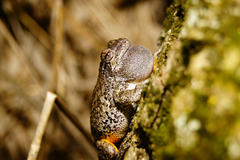Stuck inside? Time to add observations from the past
Mary Kennedy, organizer of several East Coast CNC events just emailed "Perhaps people out west need an activity this winter – perhaps at some point before travel restrictions they had the great fortune to visit the east coast. If they took any photos of local flora/fauna maybe this is a great time to practice uploading old photos that are in danger of being forgotten."
Actually, its a great idea to add observations from the past no matter where they are from - that magical trip to the tropics, that tour of the mountains, or summers spent at the cottage - the minimum requirements can be pretty easy to meet - an image that shows the organism, where it was observed and what day it was seen. The photos don't have to be perfect - simply to record the organism that you saw.
Phone photos usually have both the location and the observation time already in the digital file. if you are using the app to upload, just choose the library option and then select the image you want.
I usually use my computer for this task rather than my phone app - i long ago ran out of room on my phone for iNat images :). There's a green upload button near the top of every page of the website - I think they want to make it easy for you to find. Clicking on the button opens a page where you can either drag and drop the images or click on 'Choose images' and select the ones that you want. I find that uploading no more than about 50 images at a time is about right for my Internet connection (ymmv)
Each image will end up by default in its own little observation, represented by a bordered tile. You can select several tiles and click on combine to group multiple images of the same organism in the same observation. If you have an image that has two organisms - like a bee on a flower for example - use the duplicate button to make a copy. If you change your mind about an image, use remove to take it out of the queue.
Each observation needs three pieces of data added - the date, the place and what you think it is. The web page will try to read the date and place from your uploaded images - if it can't then you will need to add this data manually. You can edit more than one image by selecting them and then using the fields to the left of the web page to add the data. I have saved a bunch of the places where i go again and again in my pinned locations. This makes it super simple to add observations from those locations.
Identifying organisms doesn't have to be complicated - if you know the species, just type it in. Keep an eye on what ends up in the field - some common names aren't as specific as we might expect. If you are less sure - or can't find the name you know the organism by in the list - then just add the general group you think it belongs to. At its simplest, this is just choosing between plants, animals and fungi.
Add comments to the observations if you like - anything that you think important about what you saw, or where and when you saw it fits here. Then when all is ready , hit that green 'submit observations' button.
Here's some links to early observations in iNat - add a comment if you can add something earlier so I can update the post :)
- March 24, 1974 the earliest observation uploaded from our event boundaries
- July 22, 1933 the earliest observation uploaded from Manitoba
- August 15, 1938 the earliest observation uploaded from Canada
- January 1, 1801 the earliest observation uploaded from the world

































Comentarios
Agregar un comentario